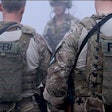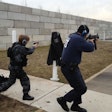My recent SWAT Web columns have dealt with the most important issues facing SWAT today. Reader response has been enlightening, reflecting the differing opinions between patrol and SWAT.
It's my belief that active shooter response has resulted in a significant challenge for the future of SWAT. Last time, I compared SWAT to emergency medicine, with patrol as "paramedics" and SWAT as "surgeons."
Another SWAT analogy is military Spec Ops—both types of teams are hybrids tasked with "special" missions considered beyond the capability of patrol—notably in response to snipers and riots. The 1960s were America's "riot era," but by the mid-1970s, snipers and riots were less frequent and less intense.
The rise of hostage and barricade incidents during the 1970s gave rise to the "hostage negotiation era." An unfortunate side effect soon manifested itself—in the form of "talk vs. tactics" friction between many SWAT and CNT teams.
The 1980s introduced another SWAT era, that of "crack/rock cocaine," pitting SWAT against the nationwide explosion of heavily armed and fortified drug dealers willing to take on police.
The 1980s also introduced a new, deadly challenge for law enforcement: active shooters. Typical patrol wait for SWAT response proved ineffective. However, that changed after Columbine, with rapid deployment becoming the new gold standard response. Because of the urgency of active shooters, relying on first responders to act, not SWAT, has become the primary strategy. The reason is simple: active shooter response requires rapid intervention, and most SWAT teams aren't able to respond rapidly enough to neutralize the threat.
Let's pause for a moment to look at reality. The majority of police are assigned to patrol, while only 1 to 2 percent are assigned to SWAT. The fact is it's impossible for SWAT to be everywhere, immediately. Cash-strapped agencies cannot afford larger SWAT teams. As a result, today we expect rapid intervention by first responders, who are oftentimes trained by SWAT, and must meet the brunt of the challenge. Many part-time SWAT officers are assigned to patrol and carry their SWAT weapons and equipment with them to enable their rapid deployment when necessary. Some full-time teams assign personnel to back up patrol during peak crime hours, thus reducing "scramble time."
I need to also point out that other than active shooters, SWAT deployment continues as the primary tactic for resolving most high-risk situations, with patrol continuing to "hold down the scene" until SWAT's arrival. Except when immediate intervention is required, this is a system that has worked well for law enforcement for the past 40 years.
It's my belief that SWAT is not only here to stay, but will become even more important in the future. That's because of the combination of an increasingly violent society and the very real threat of terrorism. When widespread terrorist attacks hit America, SWAT's role will become more critical, and will predictably result in larger SWAT teams. The exact opposite prediction from those who think SWAT is on its way out the door.
The main reason is what's coming our way—low-intensity warfare—and with it, an increasingly sophisticated, coordinated threat. To get an idea of the future, we only need to look at the present in the Middle East, where urban guerilla combat is the preferred method of warfare. One result is that Spec Ops are increasing in both mission and size and changing the face of traditional military strategy and tactics. And that's where SWAT fits into the picture: "unconventional" response to "unconventional" high-risk threats. It's what SWAT does best, and should be allowed to do—all the time.
Full-time SWAT teams have a big leg up on their part-time counterparts. But if these predictions are correct, someday full-time SWAT might become the norm, instead of the exception. Ask any SWAT operators their opinion, and they will almost universally agree they'd prefer to be on full-time teams. Add to this, the expected large numbers of military who will someday transition to law enforcement—with a high percentage of them doing so to bring their urban combat experience to SWAT.
Back to today's reality. The vast majority of SWAT is part-time, with full-time considered a luxury only large agencies can afford. I can't tell you when that will change. However, I can tell you why it will change. It will change if/when the threat level reaches "critical mass." If there is one thing that SWAT does well, it's preparing for threats and challenges above and beyond the capability of most in law enforcement.
While we're "waiting" for this to happen, we need to focus on preparations to become better than our adversaries. In the wise words of a good friend, former Special Forces and SWAT Commander and fallen warrior Terry Thorpe, "When you aren't practicing, somewhere, someone is, and when you meet him, he will win."












